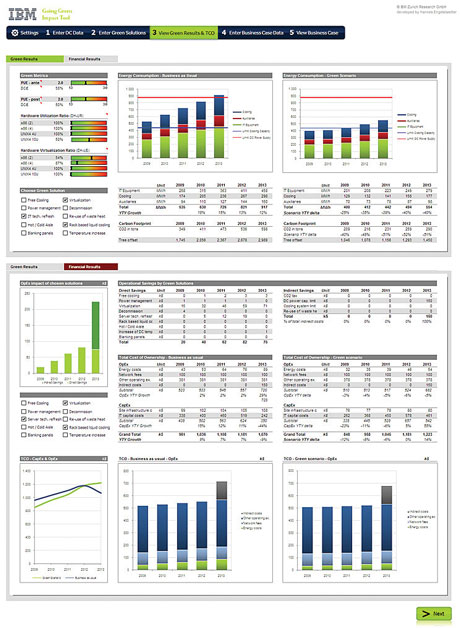by Hannes Engelstaedter
The Going Green Impact Tool (GGIT) provides a fast and comprehensive insight into the key environmental and economical aspects of data centres, allowing executives to make faster and better decisions on cost-saving potentials, business continuity and long-term IT strategies. The tool allows different dynamic scenarios to be run, which include simulating various business risks and visualizing the impact of green solutions on energy efficiency, Total Cost of Ownership (TCO) and business continuity.
In times of economic crisis, IT executives must deal with severe organizational budgetary cuts while trying to manage their business portfolios. At the same time, concerns about rising energy demands, escalating electricity prices and greenhouse gas emissions are limiting growth of information technology (IT) business areas and IT service providers. Up to this point, the focus has been on meeting the rapidly increasing computing demand. New high-performance and high-density IT equipment has been deployed, doubling the energy consumption of data centres between 2000 and 2005. However, this development is accompanied by urgent new concerns: rising energy consumption and electricity costs will cause operating expenses to exceed server capital expenses by 2009. According to research studies, power and cooling limits were reached in 50% of the world’s data centres by the end of 2008. Governments, in particular in the EU and the US, are working on new legislation for environmental protection, affecting all operations – including IT products – that cause emissions of CO2 or other greenhouse gases. Furthermore, because of the prominence of global warming concerns, green IT is becoming part of Corporate Social Responsibility (CSR) for any company. Chief Information Officers (CIOs) and other executives therefore face the challenge of developing an IT strategy to minimize those risks, to become more energy efficient, and to reduce operating and investment costs to ensure the company’s growth.
Fortunately, there already exist solutions to improve the energy efficiency of data centres and reduce risks, while enabling CIOs to meet expanding business needs on a shrinking budget. However, because of the diversity of design and requirements of data centres, there is no single perfect strategy. Depending on the issues, one must choose from a long list of possible solutions, which vary by impact, cost and sustainability. While there are tools to aid this choice, most are either too technical or too specialized to assist the CIO or other executives in mastering the challenges of becoming energy efficient.
To determine the most effective strategy, CIOs need to develop a holistic view. They must not only focus on energy-related issues but also assess the situation from an economic point of view and with a long-term perspective. Some green solutions are only useful as quick fixes, whereas other, more complex solutions requiring upfront investment will eliminate energy issues and emerging business risks. A holistic assessment thus has the advantage of finding the ideal mix of solutions with an optimum return on investment.
Perhaps the primary difficulty for CIOs is where to begin. Selecting solutions, setting priorities and determining the level of accuracy of the assessment are all nontrivial tasks to perform in-house,.and calling in consultants has its own problems. For instance, consulting offers based on significant data gathering and analysis without the necessary tool support lead to high costs. Furthermore, it is questionable whether such offers are truly objective or are influenced by the consultants’ partners.
In response to these problems, the ‘Going Green Impact Tool’ was developed to reveal existing issues, to provide a quick assessment within dynamic scenario calculations, and to provide first recommendations to executives. The tool is particularly intended to address energy-related issues from an economic point of view.

Screenshot of the Going Green Impact Tool.
On the one hand, it allows the important holistic assessment to be made in technical and economic terms. On the other hand, it supports the process of finding the right green solutions and of prioritizing their realization correctly. The energy-related issues of data centres are assessed, and the impact of green solutions on energy efficiency and the Total Cost of Ownership (TCO) is quantified. The green solutions currently included in the tool’s calculations are virtualization, IT equipment refresh, decommissioning of unproductive IT equipment, power management, direct liquid cooling, free cooling, and the reuse of waste heat; and the list is growing constantly.
The key differentiator of the ‘Going Green Impact Tool’ is the ability to compare a variety of potential energy-efficient solutions with business as usual. To ensure that the most important business risk factors are taken into account, it is possible to simulate IT equipment growth, the increase of electricity prices, a CO2 tax, data centre power supply limitations and cooling system limitations.
Finally, having decided which energy efficient solutions will be realized and when, the user can run a financial analysis of the green project to determine the overall cost. This analysis provides information on the return on investment, cash flow, net present value and payback period.
As the tool was developed to support executives in developing strategies for green data centres, the underlying principle is the Pareto principle, also known as the 80-20 rule. This avoids excessive complexity, ensures that the important holistic view is applied and provides results within days rather than weeks or months.
The ‘Going Green Impact Tool’ provides the right support for mastering energy-related issues in data centres. It ensures the necessary holistic view and includes economic aspects through a TCO analysis and business case. Furthermore it provides a solid foundation to maintain business continuity, to prevent being trapped by new environmental regulations, and to ensure acceptable operating costs in the long term. While data centres will soon face many budgetary and energy-related challenges, now is the right time to start dealing with these challenges by using the ‘Going Green Impact Tool’.
Please contact:
Hannes Engelstaedter
IBM Deutschland, Germany
Tel: +49 175 4361 777
E-mail:










